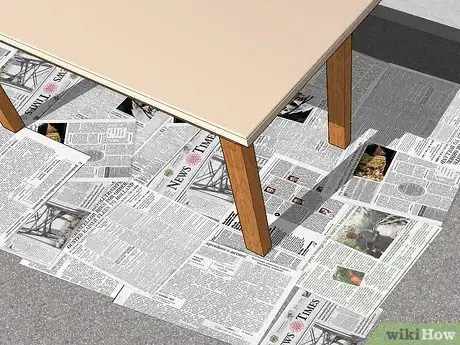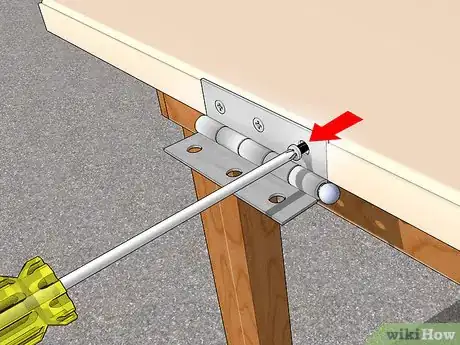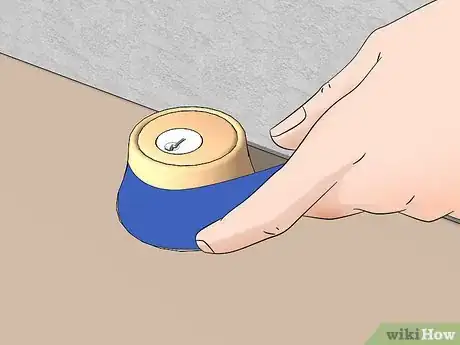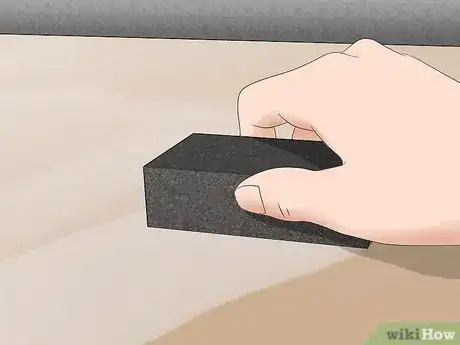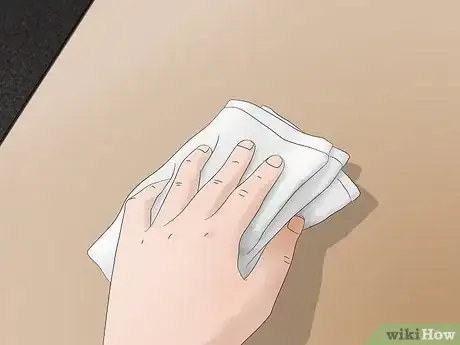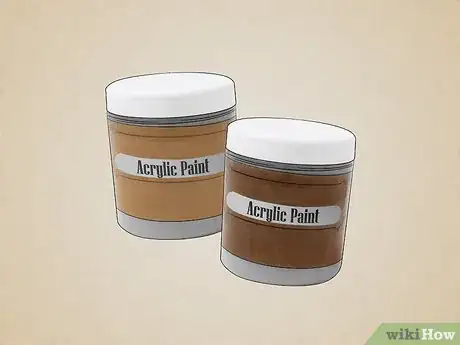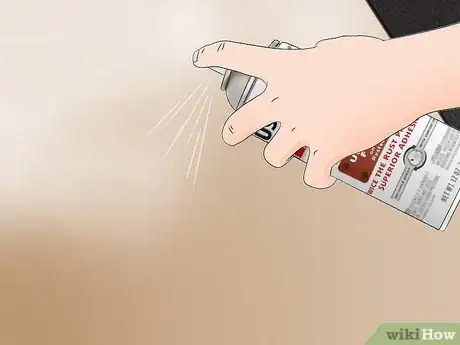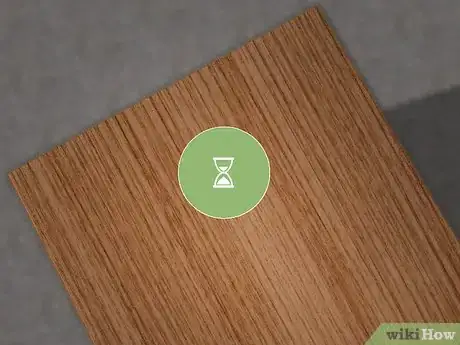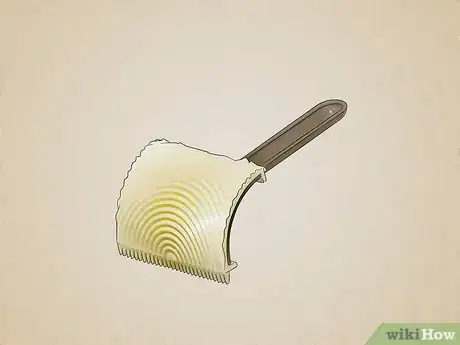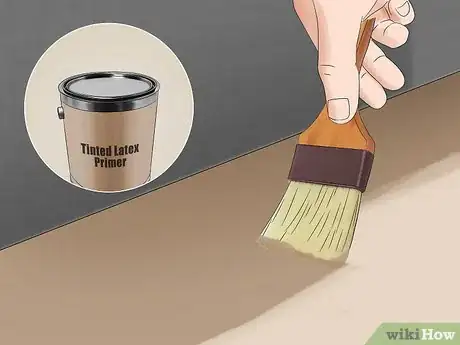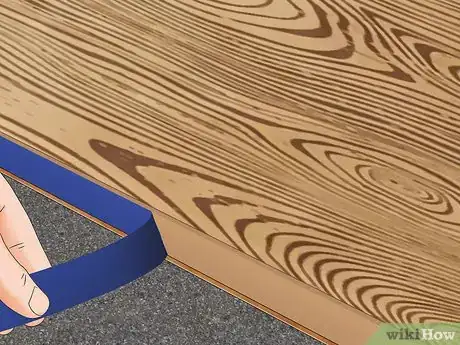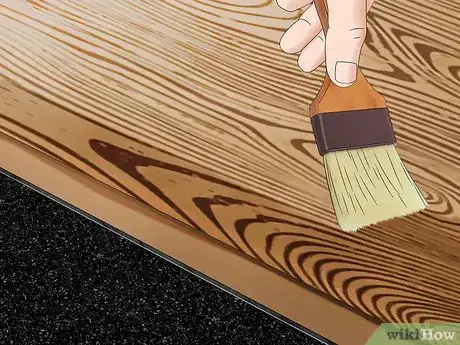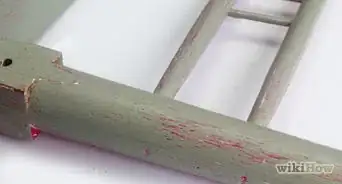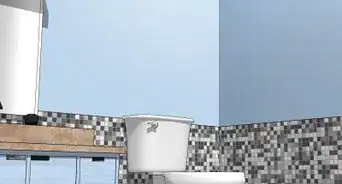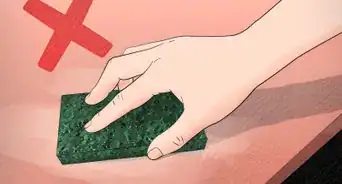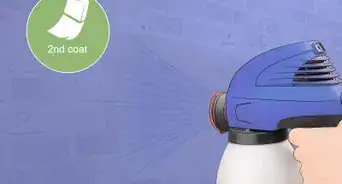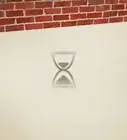X
This article was co-authored by wikiHow Staff. Our trained team of editors and researchers validate articles for accuracy and comprehensiveness. wikiHow's Content Management Team carefully monitors the work from our editorial staff to ensure that each article is backed by trusted research and meets our high quality standards.
This article has been viewed 57,856 times.
Learn more...
With the right technique and tools, you can get paint to resemble just about any surface, including wood. While the dry-brushing technique is suitable for small craft projects, a woodgrain rocker is more convenient to use on larger projects. Once the paint dries, you can apply varnish it to make it look even more like wood.
Steps
Part 1
Part 1 of 4:
Preparing and Sanding the Surface
-
1Protect your workspace against stains. Cover the surface that you will be working on with a drop cloth, newspaper, or cheap tablecloth. If there is anything near by that could get stained, move it out of the way or cover it up with a drop cloth or cheap tablecloth. It would be a good idea to wear some old clothing or a work apron as well.
- If you will be working with spray paint or oil-based paint, open up some windows to ensure good ventilation.
-
2Remove all hardware, if needed. This includes things like knobs, hinges, and metal plates. Place everything into labeled zippered bags or containers. Skip this step if you are working on a craft item with nailed or glued hardware. Removing this type of hardware will do more damage than good.Advertisement
-
3Cover anything that you do not want painted with painter's tape. This includes nailed or glued hardware that you could not remove on craft items. Run your fingernail or a burnishing tool across the tape to ensure a tight seal. If you don't have a tight seal, the paint can seep under the tape and give you a blurred line.
- It is best to use painter's tape as opposed to masking tape because painter's tape is less sticky. Masking tape is more likely to mar the surface or leave behind hard-to-clean residue.
-
4Sand the surface smooth. Start with a sanding block to smooth away any imperfections, then move on to sandpaper. If you are working with a rough surface, start with 60- to 80-grit sandpaper, then move onto a finer grit once the surface is evenly sanded. If you are working with a smoother surface, start with 120-grit sandpaper and move to 220-grit.[1]
-
5Clean the surface to remove any sanding dust and previous grime. Wipe the surface with a tack cloth, then clean it with warm, soapy water. Scrub any stubborn areas with an old toothbrush or manicure brush. Rinse the surface with fresh water, then let it dry completely.[2]
- If the item you are painting is made from plastic, wipe it down with rubbing alcohol after you wash it with soap and water. Let the item air dry after you wipe it with rubbing alcohol.
Advertisement
Part 2
Part 2 of 4:
Using a Brush for Small Surfaces
-
1Choose light, dark, and medium shades of brown acrylic craft paint. Start with a medium shade of brown for your base. Next, choose 1 darker shade and 2 to 4 lighter shades of brown for the shadows and highlights.[3]
- This method works best for smaller items as well as items with lots of curved surfaces, such as decorative boxes or plaques.
- For a more apparent woodgrain, choose 1 to 2 shades that are significantly darker and lighter than your base coat.
- There are different types of brown, including golden, reddish, and copper. Each of these will mimic a different type of wood.
-
2Apply a coat of acrylic primer and let it dry. Choose an acrylic primer that is suitable for the surface you are working on: wood, metal, plastic, etc. Apply the primer with a wide, flat paintbrush. If you are using a spray-on primer, then apply it in a well-ventilated area using a sweeping motion. Let the primer dry completely before moving on to the next step.[4]
- The color does not matter, but white or gray will work the best.
- How long the primer takes to dry depends on what you are using. Most primers will take about 20 minutes to dry.
-
3Paint the entire object using your medium brown shade, then let it dry. Apply an even coat of paint using a wide, flat paintbrush. Make sure that you cover the entire surface of the object, including any nooks and crannies. Allow the paint to dry before moving on.[5]
- If you are working on an ornately-carved surface, use a small, pointed brush to get the paint into the cracks.
-
4Apply the darkest shade of acrylic craft paint using a dry paintbrush. Pour the darkest shade of brown you have into a tray or shallow dish. Dip a wide, flat paintbrush into the paint, then wipe it a few times across a paper towel to remove the excess paint. Run the brush along the surface in straight lines, from top-to-bottom. Make sure that you go over the entire surface so that it gets evenly covered in streaky, dark-brown lines.
- A brush with stiff, coarse bristles, such as a boar bristle brush, will work the best for this. Do not use camelhair brushes; they are too soft.
- Use a small, pointed paintbrush to get the paint into any nooks and crannies as well.[6]
-
5Let the paint dry before layering on the other colors. Start with the darker shade first, then work your way up to the lighter shades. Let each color dry before moving onto the next color. Use a clean brush for each color, and remember to run the brushes across paper to remove excess paint. Make sure to apply each color to the entire surface of the object; the dry brushes will leave behind natural, woodgrain-like streaks.[7]
- The paint should not take long to dry, especially since you are dry-brushing it. Expect to wait 10 to 15 minutes at the most.
- Do not over-do it. Use a single coat for each color, and apply the lightest shade sparingly.
Advertisement
Part 3
Part 3 of 4:
Using a Woodgrain Rocker for Large Surfaces
-
1Obtain a woodgrain rocker. It is a special wedge-shaped tool that's mounted onto a handle. The wedge has curved lines carved into it, which mimic a woodgrain texture when you rock and drag it across a painted surface. It is often sold as a kit with a smaller woodgrain rocker as well as a comb-like tool. You can find it in hardware and paint-supply stores.
- This method is best suited to large, flat surfaces, such as doors and tables.
-
2Apply a tinted latex primer to the surface, and let it dry. Choose tan or beige-tinted latex primer. Apply the primer using a synthetic bristle brush in overlapping rows from one end of the surface to the other. Let the primer dry completely before moving on. This may take up to an hour, or even longer.[8]
- The paint may take longer to dry if it is very cold or humid where you live.
-
3Mix a darker wood shade with acrylic glaze. Choose a latex paint color that is 2 to 3 shades darker than the one you just applied. Mix it with equal parts of acrylic glaze in a jar. Close the jar tightly and shake it to mix the color. You'll get a translucent glaze.[9]
-
4Apply the translucent glaze to your surface in a 6 in (15 cm) strip. Do not paint the entire surface just yet. Instead, use a synthetic bristle brush or a roller to apply the glaze in a 6 in (15 cm) wide strip on the left or right edge of your surface. Work your way from the top of the object to the bottom.[10]
- If you are right-handed, apply the paint to the left edge. If you are left-handed, apply the paint to the right edge.
- Do not apply the paint to the entire surface. You want to work in 6 in (15 cm) wide strips at a time.
-
5Drag and rock the woodgrain rocker across the wet paint. Place the woodgrain rocker on top of your surface, so that its top edge aligns with the top edge of whatever you are painting. Slide the rocker down towards the bottom edge of your surface, while slowly rocking the tool downward.[11]
- Pull the comb along the edge of your completed grain for a more natural appearance.
- For a smaller grain, rock the tool up and down while dragging it.[12]
-
6Wipe your tools clean, then repeat the process. Wipe all of your brushes, woodgrain rockers, and combs clean first. Apply another 6 in (15 cm) wide strip of your glaze-paint solution right next to the first strip. Immediately drag and rock the woodgrain rocker down the newly-painted strip. Run the comb that came with the kit along the edge, if desired. Keep working like this until you reach the other side of the surface.[13]
- If the texture is too bold for you, tone it down by running a soft-bristled brush over it. Do this before the glaze finishes drying.
Advertisement
Part 4
Part 4 of 4:
Finishing the Project
-
1Remove any painter's tape that you applied earlier. Peel the tape straight up; do not drag it to the side, or you may get chips. If you do get a chip in the finish, touch it up using a small, pointed paintbrush and a matching paint color.
-
2Let the paint dry and cure completely. How long this takes depends on the type of paint that you are using. Acrylic paint typically takes about 20 minutes to dry, while latex paint may up to an hour or longer. Read the label on your bottle or can of paint to find out the exact drying time.
- Some latex paints include a curing time, which can take as little as 48 to 72 hours, to as long as 7 to 20 days. If your paint has a curing time, be sure to include it in your total drying time.
-
3Seal the surface with a varnish, if desired. This will not only protect the surface, but it will also help accentuate the woodgrain. If you painted the surface with latex paint, apply a thin coat of polyurethane varnish with a soft-bristled brush.[14] If you painted the surface with acrylic paint, you can apply a thin layer of acrylic sealer with a wide paintbrush. You can also use a spray sealer in a well-ventilated area instead.
- You can apply more than 1 coat of sealer. Let the first coat dry before applying the next one.
- Use a glossy or satin sealer if you want a fancy finish. Use a matte sealer if you want a natural finish.
-
4Let the varnish dry and cure completely. Just because something feels dry to the touch doesn't necessarily mean that it is ready to use. Read the label on your bottle or can of varnish, and note the drying and the curing times. This is very important. If you don't let the varnish cure before using the object, it may get tacky.
- Most varnishes will dry to the touch in less than an hour, but often require several hours or days to finish curing.
-
5Replace any hardware that you removed earlier. Once the surface has finished drying and curing, you can replace the hardware. If you did an antique finish on your faux wood surface, consider brushing some darker paint onto the hardware so that it will look old, like the wood. After this, your object is ready to use.
Advertisement
Expert Q&A
-
QuestionCan you stain over stain without sanding?
 Sam AdamsSam Adams is the owner of Cherry Design + Build, a residential design and construction firm, which has been operating in the Greater Seattle Area for over 13 years. A former architect, Sam is now a full-service contractor, specializing in residential remodels and additions.
Sam AdamsSam Adams is the owner of Cherry Design + Build, a residential design and construction firm, which has been operating in the Greater Seattle Area for over 13 years. A former architect, Sam is now a full-service contractor, specializing in residential remodels and additions.
Professional Contractor If the stain has been on there for a while, then you don't have to do anything special. If it was just recently applied, though, I'd make sure to use an oil based paint; if you you go over it with latex paint, you could be setting yourself up for that latex paint to fail.
If the stain has been on there for a while, then you don't have to do anything special. If it was just recently applied, though, I'd make sure to use an oil based paint; if you you go over it with latex paint, you could be setting yourself up for that latex paint to fail. -
QuestionMy faux shelf is brown. How do I get a white, shabby chic effect?
 AnonymousSuperWriterCommunity AnswerAll you need you do is to buy white paint and then apply the paint to your furniture.
AnonymousSuperWriterCommunity AnswerAll you need you do is to buy white paint and then apply the paint to your furniture.
Advertisement
Warnings
- Don't let acrylic paint dry on your paintbrushes, or you won't be able to clean them.⧼thumbs_response⧽
Advertisement
Things You'll Need
- Newspaper, drop cloth, or cheap tablecloth
- Painter's tape (optional)
- Sanding block
- Medium- to fine-grit sandpaper
- Tact cloth
Using a Brush for Small Surfaces
- Paintbrushes, wide/flat
- Paper towels
- Acrylic paint, different shades
- Clear, acrylic sealer (optional)
- Primer (optional, but recommended)
Using a Woodgrain Rocker
- White primer (oil-based)
- Paintbrushes or paint rollers
- Latex shades, 2 different shades
- Clear acrylic glaze
- Glass jar, for mixing
- Woodgrain rocker kit
- Polyurethane varnish (optional)
References
- ↑ https://www.bobvila.com/articles/paint-that-looks-like-wood/#.WgDBGYiX1PY
- ↑ http://www.house-painting-info.com/articles/faux-oak-wood-grain/
- ↑ https://www.theshabbycreekcottage.com/faux-wood-paint-finish.html
- ↑ https://thistlewoodfarms.com/how-to-paint-anything-to-look-like-wood/
- ↑ https://www.theshabbycreekcottage.com/faux-wood-paint-finish.html
- ↑ https://thistlewoodfarms.com/how-to-paint-anything-to-look-like-wood/
- ↑ https://www.theshabbycreekcottage.com/faux-wood-paint-finish.html
- ↑ http://www.house-painting-info.com/articles/faux-oak-wood-grain/
- ↑ https://www.bobvila.com/articles/paint-that-looks-like-wood/#.WgDBGYiX1PY
- ↑ https://www.bobvila.com/articles/paint-that-looks-like-wood/#.WgDBGYiX1PY
- ↑ https://www.bobvila.com/articles/paint-that-looks-like-wood/#.WgDBGYiX1PY
- ↑ http://www.house-painting-info.com/articles/faux-oak-wood-grain/
- ↑ https://www.bobvila.com/articles/paint-that-looks-like-wood/#.WgDBGYiX1PY
- ↑ http://www.house-painting-info.com/articles/faux-oak-wood-grain/
- ↑ http://www.house-painting-info.com/articles/faux-oak-wood-grain/#.Whc2u0xFxPY
- ↑ https://www.bobvila.com/articles/paint-that-looks-like-wood/#.Whc4DUxFxPY
About This Article
Advertisement
